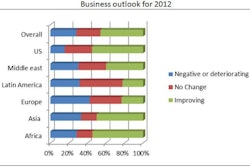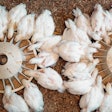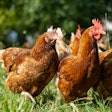The market share of red meat in 1970 (mostly beef and pork) was 75 percent of total U.S. meat consumption while the consumption of poultry (mostly chicken and turkey) was just 25 percent. Over the years, while the total consumption of meat remained remarkably stable near 200 pounds per capita (retail weight basis), the poultry proportion increased by 50 pounds while the red meat proportion dropped 50 pounds. By 2015, the market share of red meats and poultry are likely to each be 50 percent of U.S. meat consumption (100 pounds each).
This remarkable shift in meat consumption has, of course, a lot to do with the cost of production of various meats over the years and their price in the marketplace. In a nutshell, chicken got cheaper compared to beef and pork. In 1970 beef was 2.4 times as expensive as chicken while in 2012 that had increased to 3.95 times as expensive.
Inflation-adjusted prices
Another way to compare price is to make an adjustment for inflation. Adjusting for inflation determines what an item from the past would cost in today’s dollars. When making that adjustment it is interesting to note that beef is about the same price today as it was 40 years ago, pork is about 20 percent less expensive and chicken is about 50 percent less expensive. Red meats lost market share to those meats that are significantly less expensive today than they were 40 years ago.
Americans are still quite willing to spend money on red meat. Of the total amount spent by Americans on meat, 75 percent goes to red meat and only 25 percent goes to poultry. Economically speaking, it would be correct to say that Americans have a great desire, even a preference, to purchase red meat. However, it is also undoubtedly true that Americans appreciate the ability to fill in the other 50 percent of their meat consumption using only 25 percent of their dollars spent for meat.
Given the feed conversion advantage of poultry meats compared to red meats and the persistently high grain prices that appear to be a fact of life in the 21st century, it can be expected that poultry will continue to gain market share on beef and pork in the U.S. as well as worldwide.
Worldwide trends
When looking at the entire world, pork, despite being more expensive than chicken, currently has the highest per capita consumption at 15 kg (33 lbs) due, in part, to the strong preference in China for pork. Pork is followed by chicken at about 12 kg (26 lbs) and then beef at 8 Kg (18 lbs).
If current trends continue, beef consumption will slowly decline over time, pork consumption will rise slowly and chicken consumption will rise faster, gaining on pork. Eventually, chicken may surpass pork, but it looks like it may take another 20 years.


















